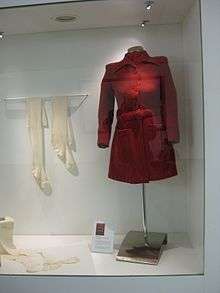Utility clothing
The Utility Clothing Scheme was a rationing scheme introduced in the United Kingdom during World War II. In response to the shortage of clothing materials and labour due to wartime austerity, the Board of Trade sponsored the creation of ranges of "utility clothing" meeting tight regulations regarding the amount of material and labour allowed to be used in their construction. Utility clothing, and later utility furniture, was marked with the CC41 tag.[1] In spite of its austere specifications, utility clothing designs were commissioned from leading fashion designers including Hardy Amies, Norman Hartnell and other members of the Incorporated Society of London Fashion Designers.[2]




Utility clothing
During the war, the government took control of supplies of raw materials for manufacturing Utility garments. They imposed regulations which took into consideration the economic condition of the country. Conserving raw materials such as cloth, wool, leather etc. was advisable because of limited supplies.[3] Manufacturers had their quota to produce Utility clothing which was 85% of the total production. The board of trade allowed the 15% left for the garment industry to create non-Utility clothing by meeting the style required in the regulations.[1]
The garment industry was encouraged to produce limited stocks in order to sustain the needs of civilians and reduce the choices available to buyers and to maintain an essential quantity of garments.[4] Utility garments were liable to price control to be sold at low prices so that civilians could afford an outfit of reasonable quality.[5] Utility clothing continued into children's wear, which also had the same CC41 label.[1]
In spite of regulations and the limitation of raw materials, manufacturers and the garment industry created a variety of styles and colours of Utility clothing of satisfactory quality.[6]
Utility shoes
The design of Utility shoes was chunky and solid. They had wedges or low two inch heels. Wearing open-toed shoes was prohibited as impractical and unsafe.[1]
Details of CC41
Examples of details of restriction orders when making Utility dress: it could have no more than two pockets, five buttons, six seams in the skirt, two inverted or box pleats or four knife pleats, and one hundred and sixty inches (four metres) of stitching. No superfluous decoration was allowed. It should be simple, practical, agreeable-looking, inexpensive and made of good material.[7]
See also
References
- "1940s Fashion - Utility scheme". Hull Museums Collections. Retrieved 1 January 2012.
- Daoust, Robert (18 February 2010). "Fahion or ration: Hartnell, Amies and dressing for the Blitz". The National Archives. Retrieved 28 October 2019.
- Robinson, Julian (1980). Fashion in the 40s. New York: St. Martin's Press. ISBN 978-0-31228-456-5.
- English, Bonnie (2007). A Cultural History of Fashion in the 20th Century. New York: Berg. ISBN 978-1-84520-342-9.
- Baylay, Ian. "An Introduction to Utility Clothing". 1940s Society. Retrieved 30 October 2019.
- Seleshanko, Kristina (1996). Vintage Fashion for Women 1920s-1940s. Atglen, Pennsylvania: Schiffer Publishing. ISBN 978-0-88740-986-8.
- Laboissionniere, Wade (1997). Blue Prints of Fashion: Home-Sewing Patterns of the 1940s. Atglen, Pennsylvania: Schiffer Publishing. ISBN 978-0-76430-304-3.
External links
- liztregenza (22 August 2011). "Utility and CC41". Advantage In Vintage.
- Crawford, Dawn (23 August 2012). "CC41 - Utility Clothing of the 1940s". Candysays.co.uk.